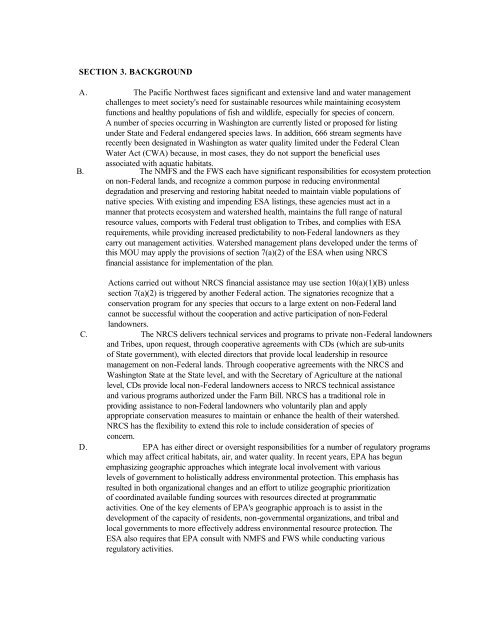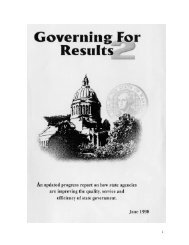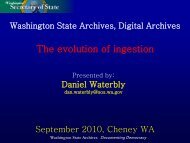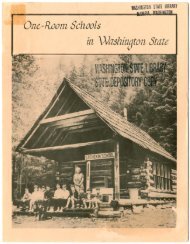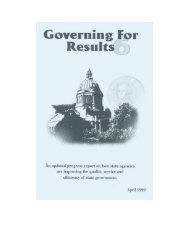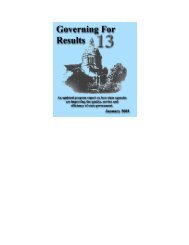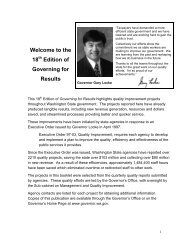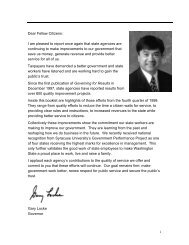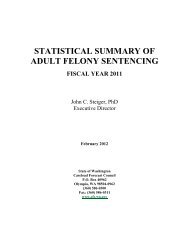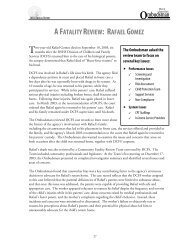MEMORANDUM OF UNDERSTANDING Between THE STATE OF ...
MEMORANDUM OF UNDERSTANDING Between THE STATE OF ...
MEMORANDUM OF UNDERSTANDING Between THE STATE OF ...
Create successful ePaper yourself
Turn your PDF publications into a flip-book with our unique Google optimized e-Paper software.
SECTION 3. BACKGROUND<br />
A. The Pacific Northwest faces significant and extensive land and water management<br />
challenges to meet society's need for sustainable resources while maintaining ecosystem<br />
functions and healthy populations of fish and wildlife, especially for species of concern.<br />
A number of species occurring in Washington are currently listed or proposed for listing<br />
under State and Federal endangered species laws. In addition, 666 stream segments have<br />
recently been designated in Washington as water quality limited under the Federal Clean<br />
Water Act (CWA) because, in most cases, they do not support the beneficial uses<br />
associated with aquatic habitats.<br />
B. The NMFS and the FWS each have significant responsibilities for ecosystem protection<br />
on non-Federal lands, and recognize a common purpose in reducing environmental<br />
degradation and preserving and restoring habitat needed to maintain viable populations of<br />
native species. With existing and impending ESA listings, these agencies must act in a<br />
manner that protects ecosystem and watershed health, maintains the full range of natural<br />
resource values, comports with Federal trust obligation to Tribes, and complies with ESA<br />
requirements, while providing increased predictability to non-Federal landowners as they<br />
carry out management activities. Watershed management plans developed under the terms of<br />
this MOU may apply the provisions of section 7(a)(2) of the ESA when using NRCS<br />
financial assistance for implementation of the plan.<br />
Actions carried out without NRCS financial assistance may use section 10(a)(1)(B) unless<br />
section 7(a)(2) is triggered by another Federal action. The signatories recognize that a<br />
conservation program for any species that occurs to a large extent on non-Federal land<br />
cannot be successful without the cooperation and active participation of non-Federal<br />
landowners.<br />
C. The NRCS delivers technical services and programs to private non-Federal landowners<br />
and Tribes, upon request, through cooperative agreements with CDs (which are sub-units<br />
of State government), with elected directors that provide local leadership in resource<br />
management on non-Federal lands. Through cooperative agreements with the NRCS and<br />
Washington State at the State level, and with the Secretary of Agriculture at the national<br />
level, CDs provide local non-Federal landowners access to NRCS technical assistance<br />
and various programs authorized under the Farm Bill. NRCS has a traditional role in<br />
providing assistance to non-Federal landowners who voluntarily plan and apply<br />
appropriate conservation measures to maintain or enhance the health of their watershed.<br />
NRCS has the flexibility to extend this role to include consideration of species of<br />
concern.<br />
D. EPA has either direct or oversight responsibilities for a number of regulatory programs<br />
which may affect critical habitats, air, and water quality. In recent years, EPA has begun<br />
emphasizing geographic approaches which integrate local involvement with various<br />
levels of government to holistically address environmental protection. This emphasis has<br />
resulted in both organizational changes and an effort to utilize geographic prioritization<br />
of coordinated available funding sources with resources directed at programmatic<br />
activities. One of the key elements of EPA's geographic approach is to assist in the<br />
development of the capacity of residents, non-governmental organizations, and tribal and<br />
local governments to more effectively address environmental resource protection. The<br />
ESA also requires that EPA consult with NMFS and FWS while conducting various<br />
regulatory activities.


